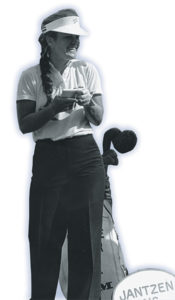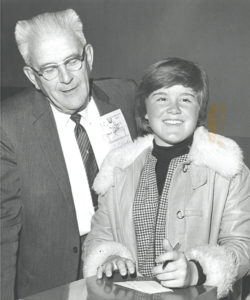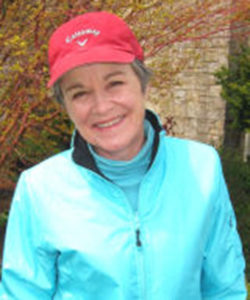by Jeff Shelley
Peggy Conley was coy when asked her age for this article. “Old enough to know better,” the Spokane native said with a chuckle.
But what a wonderful and long life in golf she has forged. At 11 years old, tagging along with her father, Glen – a three-year letterman as a lineman on the University of Washington football team – at Spokane Country Club, Peggy got the golf bug. “I thought golf was ridiculous, an old man’s game. But when Dad asked me if I wanted to hit some shots, I found it very interesting.”

Head pro Jim Shriver at Manito Golf & Country Club gave Conley and her friends free golf balls, use of the driving range and lessons in exchange for picking the practice area.
“Dad would drop me off on his way to work in the morning during the summer, and Mom would pick us up in the afternoon.”
She and her buddies soon entered competitions, with Peggy playing in the PNGA Junior Girls’ at age 13.
“I got to looking at the kids I was competing against and realized I could beat them. I won the 1961 PNGA Junior Girls’ title for my first championship win.” She followed that up with victories in 1963 and ’64 to become the only girl to win that title three times.
And so began her winding and successful career.
At just 16 years old, in 1963, the precocious teen advanced all the way to the championship matches in both the 1963 U.S. Girls’ Junior Championship and U.S. Women’s Amateur. In the first tournament, Conley, the youngest player to ever reach the finals up to that time, lost 2-up to Jan Ferraris at Wolferts Roost Country Club in Albany, N.Y. In the latter, she fell to Seattle’s Anne Sander, 2 & 1, at Taconic Golf Club in Williamstown, Mass.
The following year Conley broke through, becoming the medalist and convincingly winning the 1964 U.S. Girls’ Junior, besting Laura MacIvor 6 & 5 at Leavenworth (Kans.) Country Club.
Conley was very confident during these halcyon years. “I didn’t know I could miss a shot back then. I could hit the ball a long way, which was an advantage, and anywhere I wanted to. I never was a good putter, but I didn’t have to be. My swing was basically sound and it stayed that way.”
Just before she burst onto the national stage, Shriver recommended that Peggy take lessons from one of the region’s top professionals, Chuck Congdon, at Tacoma Country & Golf Club. “I went to him at age 15,” Peggy recalled. “Jim Shriver said he’d taken me as far as he could and told my folks I needed to see Chuck, who was working with several great players, including Pat Harbottle and Connie Guthrie.” Like Conley, both women are members of the PNGA Hall of Fame.
Though her connection with Congdon was immediate, it also led to one of the saddest periods of her life. “Chuck was a genius. He made it all work. He made it easy to hit a golf ball. After he died in 1965, I was lost for a while,” she said.
Conley considers her victories in the U.S. Girls’ Junior and the 1966 Women’s Western Amateur the highlights of her amateur career. But she was also a member of two victorious U.S. Curtis Cup teams in 1964 and ’68. “I really enjoyed playing alongside JoAnne Carner in the 1964 Curtis Cup at Royal Porthcawl in Wales. I wanted to play a practice round and no one wanted to play, except Carner. She was one of the reasons I wanted to turn pro. She’s probably one of my favorite people ever.”

Her turn as a professional would wait, as thanks to her heroics in amateur golf circles, Conley became the first woman to ever receive a golf scholarship at the University of Washington, receiving the tidy sum of $500 to cover her four years on campus. But after just two years, she was tossed from the team after a harmless prank went wrong. During a party on the seventh floor of McMahon Hall, she filled up some empty beer bottles and tossed them into the woods surrounding the dormitory. Peggy didn’t consume alcohol that night – and never has.
Unfortunately, the bottles landed on a guard shack hidden in the woods. “I was the only who got punished and I didn’t even drink,” she told Dan Raley of the Seattle P.I. in 2005. “No one got hurt or killed, but it was a stupid thing to do. I don’t even throw gum wrappers on the ground and litter.”
Despite her banishment from the team, Conley stayed at the UW for seven years and earned two degrees, before going on to teach at Overlake School for six years. But at age 29, the golf bug bit again. She quit teaching and qualified for the LPGA Tour. Her best finish in six years on that circuit was a runner-up in the late-1970s to rising star Nancy Lopez in the Sunstar Classic at Rancho Park Golf Course in Southern California. “The course reminded me of Indian Canyon, which I played a lot growing up.”
After losing her LPGA card, Conley ventured off to the Ladies European Tour, winning twice – the Portuguese Open and Volkswagen Classic in Ireland – and having a blast. “I really enjoyed Europe versus the U.S,” she said. “I was going to stay there for just a month and it ended up being seven years. I was a tourist and got to drive all around and had a wonderful time. That was probably the best time of my life.
“Playing in Belfast, Northern Ireland, was fun because of my partial Irish blood,” Conley added. “The Irish people were extraordinarily generous. Playing in Europe was almost like a vacation – tournaments in places like Paris, St. Moritz, and Ireland. I learned numbers in six different languages because I’d have different local caddies and I’d need to request clubs. When I was an amateur, I played in the British Amateur at St. Andrews and it was a spiritual experience. I was there on a Sunday and found that the golf course was closed. I was told it needed to rest. I thought that was cool.”
Unfortunately, a serious auto accident in 1991 derailed her pro career. She rounded a hairpin turn and hit another car in her lane (ironically driven by an Italian woman golf journalist). For a long stretch Conley wasn’t able to play. But all that’s in the past.

“My health is good now,” she said. “I had some residual issues with my wrist and the hand didn’t work, but I’m fine now. There was a therapist in Phoenix who rescued my career.”
The latter stage of that career involves being a golf instructor for well over 20 years. Even though she had a wealth of experience as an outstanding player and a school teacher, instructing golfers was a whole new ballgame. “Just because you’ve been a tour player, many people think you can teach. But that’s not the case,” she said. “You really need to ‘learn’ how to teach.”
She received her golf-instructor training at the John Jacobs School from 1994-2000. From there, Conley went to Sahalee Country Club for four years, the Golf Club at Newcastle (Wash.) for 10 years and is currently an instructor at GolfTEC in Southcenter in Tukwila, Wash.
Conley truly enjoys this phase of her life. “Part of teaching golf is you’re challenging people,” she said. “I might ask someone how good do you want to be? I want them to become the best player they can be with the time they have. The majority of my students are adults and they have to work. I’ve had students become club champions and that’s a real accomplishment on their part. One of my students said, ‘You’re tough,’ and I replied, ‘No, the game is tough.’”
She admits the urge to compete stirs occasionally but truly likes where she’s at. “I could still play competitively but I’d have to quit teaching,” she said. “It would take me a couple of years to get in shape. It’s tempting now that there’s the Legends Tour. I just enjoy GolfTEC; it’s the best thing for students. I don’t miss playing because of my current job.”
Conley keeps things simple for students. She recommends that all golfers need a good set-up and grip, with much of their success determined before the ball is even struck. “Practice aiming, as not enough people aim today,” she suggests. “You also need to not be too mechanical and understand the golf ball. If you understand why the ball moves the way it does, you can understand your swing.
“The biggest key is what you do before the golf swing. I’m a stickler on grip, ball position and stance. I see a lot of students who don’t get set up correctly. Sometimes, better players are harder to teach than beginners. The key to the golf swing is what happens at the ball.
“The most important thing is impact,” she continues. “Where all good and great swings are the same is impact created by the correct position ‘through the ball.’ Forget about hitting the ball. I get on my students for trying to simply hit the ball. Instead, I have them approach each shot like this: ‘I know what I want the ball to do. Now what do I do to make that happen?’ The ‘what’ is my job. The ‘do’ is up to my student.”
Good advice from one of the best – and seemingly ageless – golfers and instructors to ever come out of the Pacific Northwest.
Jeff Shelley has written and published nine books as well as numerous articles for print and online media over the past 31 years. Among his titles are three editions of “Golf Courses of the Pacific Northwest.” He was also co-author (with Michael Riste) and publisher of “Championships & Friendships: The First 100 Years of the Pacific Northwest Golf Association.” In addition to his role with First Green, the Seattle resident co-founded the Northwest Golf Media Association.
